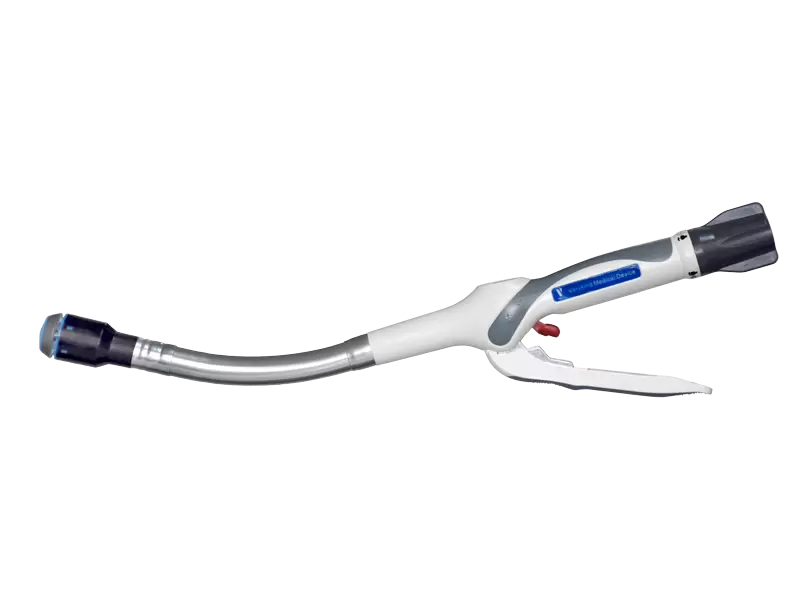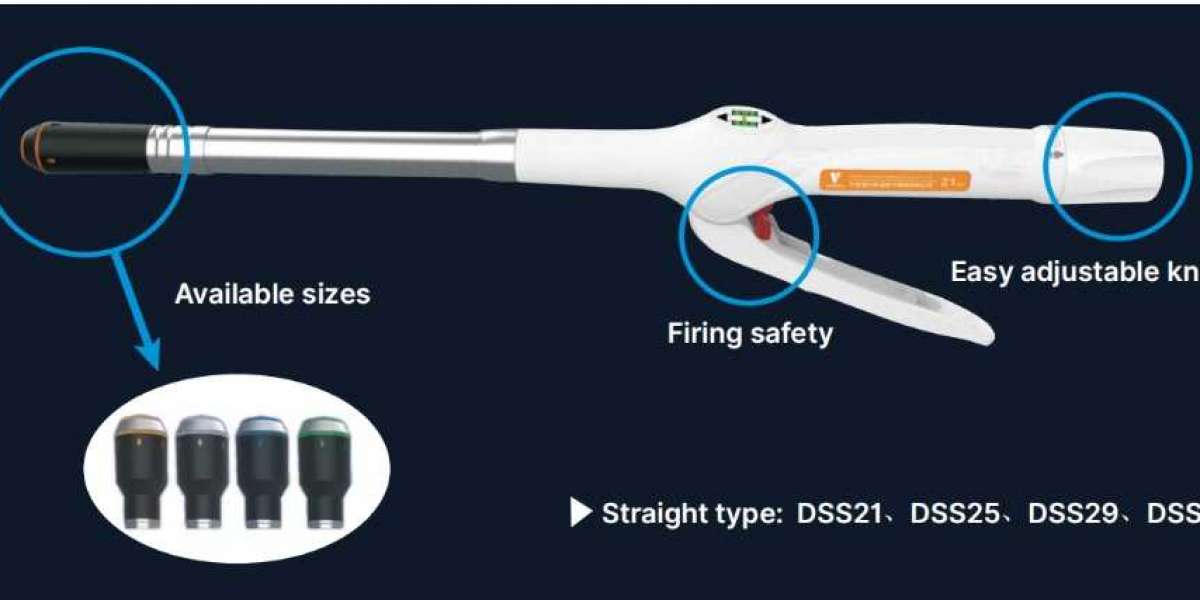Disposable intraluminal staplers have revolutionized surgical procedures, offering precision and efficiency in gastrointestinal surgeries. These innovative devices provide a safe and cost-effective alternative to traditional staplers, reducing the risk of infections and improving patient outcomes. With their ergonomic design and advanced technology, disposable intraluminal staplers ensure accurate staple formation and tissue approximation, enhancing the overall surgical experience for both patients and healthcare providers. As a crucial tool in modern medicine, these staplers play a vital role in minimizing complications and optimizing healing post-surgery.

Benefits of Disposable Intraluminal Staplers
Increased Efficiency
Disposable intraluminal staplers contribute to increased efficiency during surgical procedures. By using these staplers, doctors can save time and streamline the process of creating connections within the body. For instance, in gastrointestinal surgeries, disposable intraluminal staplers allow surgeons to quickly and effectively join tissues together without compromising on safety.
Using disposable intraluminal staplers can significantly reduce the risk of infection. Since these devices are designed for single-use only, there is minimal chance of contamination or transmission of infections between patients. This feature is particularly crucial in sterile environments like operating rooms where maintaining a clean and bacteria-free setting is paramount for successful surgical outcomes.
Enhanced Precision
One key advantage of disposable intraluminal staplers is their ability to provide enhanced precision and accuracy during surgeries. These specialized tools help surgeons create secure anastomoses with utmost accuracy, ensuring that connections between blood vessels or organs are made correctly every time. The precise mechanism of disposable intraluminal staplers minimizes the margin for error in joining tissues.
- Reduced operating time due to streamlined processes.
- Lower risk of post-operative infections.
- Enhanced accuracy in creating secure anastomoses.
Disposable Intraluminal Staplers Description
Design and Function
Disposable intraluminal staplers are specifically created for use within the gastrointestinal tract. These devices feature a circular stapler design, comprising a detachable anvil and a reloadable cartridge. The staplers are meticulously engineered to ensure precise closure of incisions or resections in the intestines.
These intraluminal staplers streamline surgical procedures by enabling efficient tissue cutting and staple formation simultaneously. Surgeons can easily manipulate these tools endoscopically to achieve accurate anastomoses or closures within the digestive system, reducing operative time significantly.
Materials and Safety
Crafted from top-notch materials, disposable intraluminal staplers guarantee optimal performance and safety during medical interventions. The high-quality components used in their construction enhance durability while minimizing the risk of malfunction or complications during surgeries.
- Pros:
- Facilitate quick and secure closure of incisions.
- Enhance precision in gastrointestinal surgeries.
- Reduce operative time, benefiting both patients and healthcare providers.
- Cons:
- Costlier than traditional suturing methods.
- Require specialized training for effective utilization.
Applications of Disposable Intraluminal Staplers
Colorectal Surgeries
Disposable intraluminal staplers are commonly used in colorectal surgeries for bowel resection and anastomosis. These staplers simplify the process by securely connecting the healthy sections of the bowel after removing a diseased portion. This method is efficient, reducing operating time and promoting faster recovery for patients. The staples provide strength to the connection, preventing leaks or separations post-surgery.
In colorectal surgeries, disposable intraluminal staplers offer several advantages:
- Quick and efficient bowel resection
- Secure anastomosis with reduced risk of leakage
- Faster patient recovery times
Gastric Bypass Procedures
These staplers are also utilized in gastric bypass procedures for weight loss surgery. During gastric bypass surgery, surgeons use these devices to create a smaller stomach pouch that limits food intake. By dividing the stomach into two sections and rerouting part of the small intestine, this procedure helps patients lose weight effectively.
In gastric bypass procedures, disposable intraluminal staplers provide various benefits:
- Precise creation of a smaller stomach pouch
- Effective restriction on food consumption
- Significant weight loss results for patients
Other Gastrointestinal Surgeries
Apart from colorectal and gastric surgeries, disposable intraluminal staplers are suitable for other gastrointestinal procedures like esophagectomy or gastrectomy. In esophagectomy, where part or all of the esophagus is removed due to cancer or other conditions, these tools aid in reconnecting the remaining portions accurately.
For other gastrointestinal surgeries like esophagectomy or gastrectomy:
- Facilitate precise reconnection after organ removal
- Ensure secure attachment between healthy tissue segments
Options for Disposable Intraluminal Staplers
Sizes Available
Disposable intraluminal staplers come in different sizes to suit various anatomical structures. This ensures that surgeons can choose the appropriate size based on the specific requirements of each procedure. For instance, smaller sizes may be used for delicate tissues or narrow lumens, while larger sizes are suitable for thicker tissues or wider areas.
These staplers offer versatility by providing multiple staple line lengths, catering to different tissue thicknesses encountered during surgeries. Surgeons can select the staple line length that best fits the tissue they are working with, ensuring secure closure and optimal outcomes. This adaptability is crucial in procedures where varying tissue thicknesses are present within a single operation.
Handle Designs
One of the key features of disposable intraluminal staplers is the availability of various handle designs aimed at enhancing surgeon comfort and ease of use. Ergonomically designed handles reduce hand fatigue during lengthy procedures, promoting precision and efficiency. Some staplers have textured grips or ergonomic shapes to ensure a secure hold even when hands are gloved and sterile.
- Different sizes accommodate various anatomical structures
- Multiple staple line lengths cater to different tissue thicknesses
- Various handle designs enhance surgeon comfort and ease of use
Comparison of Different Types of Staplers
Cost-Effectiveness of Disposable Intraluminal Staplers
Disposable intraluminal staplers are a cost-effective choice when compared to reusable ones. The initial investment in disposable intraluminal staplers may be higher, but the overall costs associated with maintenance and sterilization for reusable options make disposables more economical over time. For healthcare facilities handling a high volume of procedures, the cost savings from using disposable intraluminal staplers can be significant.
When considering the long-term financial impact, disposable intraluminal staplers stand out as a practical solution due to their affordability and efficiency. Healthcare providers benefit from reduced expenses related to sterilization processes and potential risks associated with cross-contamination that come with reusable devices.
- Pros:
- Cost-effective over time
- Reduced risk of cross-contamination
- Cons:
- Higher initial investment
Secure Anastomoses Offered by Circular Staplers
Circular staplers excel in providing secure anastomoses compared to linear staplers. These specialized surgical instruments create circular connections between hollow structures like intestines or blood vessels during surgeries. The design of circular staples ensures a tight seal that minimizes the risk of leaks post-surgery, promoting faster healing and reducing complications for patients.
Healthcare professionals often opt for circular staplers when performing procedures that require precise and secure connections between tubular structures within the body. The reliability offered by circular staples contributes significantly to successful outcomes in various surgical interventions.
- Key Information:
- Circular staplers create tight seals
- Ideal for connecting hollow organs
Efficiency Advantages of Mechanical Stapling Over Manual Suturing Techniques
Mechanical staple systems provide speed and efficiency advantages over traditional manual suturing techniques in surgical settings. By utilizing mechanical power, these advanced devices can rapidly place multiple titanium staples along incisions or tissue layers without compromising precision or strength. This streamlined process not only saves valuable operating time but also enhances procedural accuracy.
Compared to manual suturing methods that rely on hand-sewn stitches, mechanical staple systems offer consistent results while reducing operative times significantly. Surgeons appreciate the convenience and reliability provided by mechanical stapling technology across various medical specialties.
- Advantages:
- Faster procedure completion
- Enhanced precision
Single-Use Curved Intraluminal Circular Stapler
Easier Access
Disposable intraluminal staplers with a curved design are advantageous as they allow for easier access to tricky anatomical locations. This feature is particularly beneficial when operating in areas that are hard to reach or navigate using straight instruments.
These single-use staplers can maneuver through tight spaces and corners more effectively, ensuring the surgeon can reach the target area without causing unnecessary trauma or damage. For instance, when working on a deep-seated colon lesion, the curved design enables precise placement of staples without compromising surrounding healthy tissue.
Consistent Staple Formation
One of the key benefits of utilizing disposable intraluminal staplers is their ability to provide consistent staple formation along the entire circumference of an anastomosis. Unlike traditional manual suturing techniques that may result in uneven stitching or tension variances, these staplers ensure uniform closure and secure tissue approximation.
Circular Surgical Stapler for Gastrointestinal Anastomosis
Secure Connections
Disposable intraluminal staplers are specifically designed to create secure connections between two sections of the gastrointestinal tract. These staplers ensure a tight seal, preventing any leakage that could lead to complications post-surgery. The design of these staplers enables surgeons to perform precise and accurate anastomoses.
These surgical devices play a crucial role in ensuring that the connected sections remain securely sealed, reducing the risk of infection and other complications. By using disposable intraluminal staplers, surgeons can effectively join segments of the digestive tract with confidence.
Hemostasis Benefits
One significant advantage of disposable intraluminal staplers is their ability to provide excellent hemostasis during surgical procedures. This means that these staplers help control bleeding effectively while creating connections within the gastrointestinal tract. By promoting hemostasis, disposable intraluminal circular staplers contribute to safer surgeries with reduced blood loss.
- Advantages:
- Ensures secure connections
- Promotes hemostasis during surgery
- Reduces risk of leakage post-operation
- Disadvantages:
- Costlier than traditional stitching methods
- Requires proper training for effective use
Safety and Efficacy in Anastomosis Procedures
Clinical Studies
Disposable intraluminal staplers have been extensively studied, proving their safety. Clinical studies consistently show that these staplers are safe for use in anastomosis procedures. The research indicates that outcomes with disposable intraluminal staplers are comparable to or even better than traditional suturing methods.
Studies reveal that the risk of complications such as leaks, strictures, and bleeding is significantly reduced when using disposable intraluminal staplers. These findings highlight the benefits of employing this advanced technology in surgical operations.
Superior Outcomes
The use of disposable intraluminal staplers during anastomosis procedures offers several advantages over conventional techniques. One significant benefit is the reduction in operative time due to the efficient nature of staple placement. stapler devices provide consistent staple formation, promoting secure tissue apposition and reducing the likelihood of postoperative complications.
- Pros:
- Safe and extensively studied
- Comparable or superior outcomes compared to traditional methods
- Cons:
- Initial cost may be higher than traditional suturing materials
Stapler Length, Suture Length, and Staple Dimensions
Varying Staples
Disposable intraluminal staplers come in different staple lengths to suit varying tissue thicknesses. For instance, some staplers offer 2.5 mm staples for thin tissues and 3.5 mm staples for thicker tissues. This variability allows surgeons to choose the most appropriate staple size based on the specific requirements of the procedure.
Some disposable intraluminal staplers also feature multiple rows of staples to ensure a secure closure across a broader area of tissue. The versatility in staple length not only accommodates different tissue types but also contributes to the overall strength and integrity of the anastomosis.
Importance of Suture Length
Apart from staple dimensions, suture length options play a crucial role in ensuring proper closure during anastomosis procedures using disposable intraluminal staplers. Surgeons can select from various suture lengths depending on factors such as tissue thickness and surgical technique.
For example, when performing a low pelvic anastomosis where access is limited, having adequate suture length is essential for maneuverability and precise stitching. Choosing the correct suture length is vital as it directly impacts the surgeon's ability to create a secure connection between bowel segments or vessels.
Optimal Strength with Staple Dimensions
The design of disposable intraluminal staplers incorporates specific staple dimensions aimed at providing optimal strength and stability post-surgery. These dimensions include measurements such as staple height, width, and crown size that collectively contribute to effective hemostasis and tissue approximation.
Final Remarks
In conclusion, the benefits, applications, and safety of disposable intraluminal staplers make them a valuable tool in various surgical procedures. The versatility and efficacy of these staplers offer surgeons precision and efficiency, especially in gastrointestinal anastomosis procedures. With a range of options available in terms of stapler types and dimensions, healthcare providers can choose the most suitable device for each unique case, ensuring optimal outcomes for patients.
For those in the medical field, staying informed about the latest advancements in surgical tools like disposable intraluminal staplers is crucial for providing top-notch patient care. Continuous learning and adaptation to new technologies are key to enhancing surgical practices and improving patient experiences. Stay updated on emerging trends and innovations to deliver the best possible outcomes for your patients.
Frequently Asked Questions
What are the primary benefits of using disposable intraluminal staplers?
Disposable intraluminal staplers offer reduced risk of cross-contamination, convenience in handling, elimination of reprocessing costs, and consistent staple formation for reliable anastomosis procedures.
How would you describe disposable intraluminal staplers?
Disposable intraluminal staplers are single-use devices designed for creating secure anastomoses during surgical procedures. They come in various sizes and configurations to suit different clinical needs.
In what medical applications can disposable intraluminal staplers be used?
These staplers find applications in gastrointestinal surgeries, bariatric procedures, colorectal surgeries, and other operations requiring precise tissue closure or resection within hollow organs.
What options are available when considering disposable intraluminal staplers?
There are various types such as curved circular staplers for specific anatomical locations or straight linear cutters for different tissue thicknesses. Choose based on procedure requirements and surgeon preference.
How do safety and efficacy play a role in anastomosis procedures with disposable intraluminal staplers?
Disposable intraluminal staplers ensure safety by minimizing the risk of infections related to device reuse while providing efficient closure that promotes faster healing and reduces post-operative complications.







